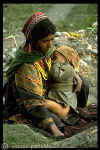|
|
||||
| Home
JUNE 2001- Contents Culture Sports Health Lifestyle Visual Arts People Travel & Adventure
|
|
|
||
|
the-south-asian.com June 2001 |
||||
|
Page 3 of 6
The Kalasha of Pakistan (cntd) Problems of Minority Development and Environmental Management By Peter Parkes
Everyday Forms of Indigenous Ignorance Within less than half a century, Kalasha have thus experienced a significant reversal of fortune: from abject feudal servitude to ever-increasing patronage through government subsidies and NGOs. These now compete to establish rival projects among their fifteen hamlets, which are prominent destinations on the scheduled itinerary of development-tourism provided for foreign aid agencies in Pakistan. Despite adverse effects in further inciting factional competition, all Kalasha have without doubt benefitted substantially from opportunities to gain local employment through such projects. But many of these projects are recognised to have been less successful in their implementation. Irrigation channels are discovered to be so misaligned as to conduct little or no water by gravity-flow; pipes for drinking water have been buried insufficiently deep and are ruptured by winter frosts; suspension bridges are washed away with the first summer floods; and flood protection walls have subsided within a few months of construction. Yet Kalasha were formerly employed for their exceptional engineering skills in building irrigation channels, aqueducts, and cantilever bridges throughout Chitral. Many other 'religious minority' funded projects are furthermore felt to be both unnecessary and undesirable: such as the needless rebuilding of altars with dressed stone and cement, the construction of new concrete 'clan temples' or tin-roofed 'dancing pavilions', which both flout ritual tradition and actually impede ritual performance. Yet all these projects were requested by Kalasha leaders or local contractors. Environmentalist programmes - such as 'afforestation' through planting exotic broadleaf saplings along irrigation channels - are similarly disparaged as either useless or harmful to traditional subsistence, although these were again apparently introduced through a series of 'participatory dialogues' with Village and Women's Organizations. As a Deputy Commissioner of Chitral lamented, 'tens of lacs [i.e. millions] of Government money have been wasted in Kalash valleys alone as I have seen myself'. Many of these problems or misconceptions of local needs undoubtedly stem from the personal ambitions of factional leaders, whose political support depends upon gaining maximal financial contracts for development projects, sometimes irrespective of their practical outcome.Yet examination of particular cases also indicates some intentional miscommunication occuring in consultations concerning Kalasha subsistence needs: a tendency to misrepresent local conditions, sometimes for no evident personal advantage. Such dissimulation is apparent in household census records collected for development assessment, where these can be identified, as well as in some very odd proposals for programmes apparently derived from group consultation. But a similar miscommunication of Kalasha indigenous knowledge, including sometimes mischievous 'inventions of tradition' for foreign consumption, is also familiar to anthropological fieldwork. As a minority, Kalasha have in fact long depended upon an intentional cultivation of misleading knowledge about themselves. This has served as a basic tactic of survival against exploitation, employing that sly repertoire of 'everyday forms of peasant resistance' famously documented in Malasia in James Scott’s Weapons of the Weak. Such is the ploy of cunning celebrated in oral traditions concerning the feudal era, where an enactment of stupidity is hilariously shown to have outwitted creduluous and greedy Chitralis. As another anthropologist, Gillian Darling, noted: ‘The Kalash generally are very aware of the need for techniques specifically intended to beguile outsiders... [and] Kalash language is particularly rich in idiomatic expressions of the type which describe these subterfuges’. Habitual strategies of dissimulation have undoubtedly served to protect Kalasha material interests in the past, as well as ensuring that a hidden sense of dignity survived beneath an obligatory facade of servility. Presentations of a persuasive appearance of wretched indigence and ignorance have also served to attract lucrative subsidies, having a complicity with the promotional programmes of NGOs concerned with 'redistributive justice' and the economic 'uplift' of disadvantaged minorities. Yet with more active intervention in Kalasha subsistence and local resource management, such continuing miscommunication of indigenous knowledge entails sometimes unforeseen collective consequences, whose adverse implications are now beginning to be grasped by a younger generation of educated leaders.
|
||||
| Copyright © 2000 [the-south-asian.com]. Intellectual Property. All rights reserved. | ||||
| Home |
